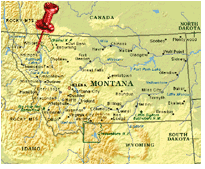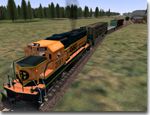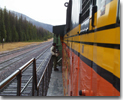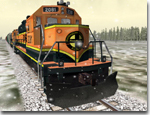|
Microsoft Train Simulator Features BNSF Route
 |
Burlington Northern Santa Fe Railway Experience the challenges and awesome power of moving today's freight through the spectacular Marias Pass and along the southern border of Glacier National Park in Montana.
|
Marias Pass Line Details
Railroads enabled the United States to expand westward across the continent. The completion of the first transcontinental railroad by the Central Pacific and Union Pacific Railroads at Promontory Summit, Utah, in 1869 was only the beginning. Other lines followed, both to the north and to the south, as the country's political, business, and industrial leaders pushed for new ports and new markets on the Pacific Coast.
 As
the railroads built west through the remainder of the 19th century, more
of the country came open for settlement, agricultural, industrial, and
mining use. However, all of the rail builders faced a similar problem:
how to cross the magnificent yet imposing Rocky Mountains. The Southern
Pacific took the 'lowland" route, constructing its line across southern
New Mexico and Arizona to California, while in 1883 the Northern Pacific
punched through the Continental Divide at 6,300-foot Homestake Pass and
5,546-foot Mullan Pass in Montana.
As
the railroads built west through the remainder of the 19th century, more
of the country came open for settlement, agricultural, industrial, and
mining use. However, all of the rail builders faced a similar problem:
how to cross the magnificent yet imposing Rocky Mountains. The Southern
Pacific took the 'lowland" route, constructing its line across southern
New Mexico and Arizona to California, while in 1883 the Northern Pacific
punched through the Continental Divide at 6,300-foot Homestake Pass and
5,546-foot Mullan Pass in Montana.
It fell to the Great Northern Railway to find a lower-elevation crossing of Montana. In 1893 the company succeeded, in the process creating one of the most spectacular rail lines in all of North America: a crossing of the Rocky Mountains at 5,213-foot Marias Pass. Over a century later, the line, now operated by The Burlington Northern and Santa Fe Railway Company, remains a dramatic and breathtaking icon of American railroading.
History of the Marias Pass line
| In 1890, the Great Northern Railway was strictly a mid-sized, upper Midwestern railroad, limited to operations in Minnesota, North Dakota, Montana, and Manitoba. However, James J. Hill, the man who assembled the Great Northern from several smaller railroads, had a greater vision: to challenge the existing Northern Pacific Railroad by building west across the Rockies and Cascades to the Puget Sound. Hill's success in creating the line, which linked the Great Lakes with the Pacific, gained him the nickname "The Empire Builder." | |
|
Click
picture for larger image.
|
Construction of the line
Construction of the line over the Rockies took about a year and followed a path surveyed by Great Northern Chief Engineer John F. Stevens. One crew laid track west from a point near Havre while another built east from a location near Flathead Lake and Kalispell. Sixty miles east of the summit, the crews were forced to build a 1,200-foot-long, 180-foot-high trestle across Cut Bank Creek. They followed with an 800-foot-long 214-foot-high trestle over Medicine Creek some 45 miles to the west. Consuming three quarters of a million board feet of timber, the massive Medicine Creek Trestle became the highest bridge on the entire Great Northern Railway.
The line skirted an immense area of mountains and glaciers, which later became Glacier National Park. Indeed, the railroad played a major role in the establishment of the park in 1910, and operated many of the park's lodges through 1960. Through the end of the Great Northern's passenger service in 1970, Glacier National Park remained a regular stop for the company's premier train, the Empire Builder, named for James J. Hill.
Running Marias Pass in Train Simulator
 Train
Simulator includes the entire BNSF mainline from Shelby to Whitefish,
as currently operated by The Burlington Northern and Santa Fe Railway
Company, as well as the 13-mile Kalispell Branch.
Train
Simulator includes the entire BNSF mainline from Shelby to Whitefish,
as currently operated by The Burlington Northern and Santa Fe Railway
Company, as well as the 13-mile Kalispell Branch.
You'll work your way west from the rolling prairies of Central Montana past fields of grain and herds of cattle and through several small farm and ranch communities, all the while keeping an eye on the spectacular Montana Rockies rising straight ahead. Along the 84 miles between Shelby and Marias Pass, you'll climb 1,950-feet, but thanks to the efforts of Great Northern's construction crews you'll never exceed a grade of 1.2 percent.
 Once
you make the long, hard climb to Marias Pass you face the really fun part
of the trip: successfully negotiating your train 79 miles down a 1.8 percent
grade, losing 2,173 feet of altitude in the process as you pass through
towns like Blacktail, Red Eagle, and Columbia Falls. Look off to your
right as you pass through Essex (18 miles west of the summit) and you'll
see the famous Izaak Walton Inn, a former Great Northern bunk house and
maintenance crew point now popular with railfans and travelers.
Once
you make the long, hard climb to Marias Pass you face the really fun part
of the trip: successfully negotiating your train 79 miles down a 1.8 percent
grade, losing 2,173 feet of altitude in the process as you pass through
towns like Blacktail, Red Eagle, and Columbia Falls. Look off to your
right as you pass through Essex (18 miles west of the summit) and you'll
see the famous Izaak Walton Inn, a former Great Northern bunk house and
maintenance crew point now popular with railfans and travelers.
 Take
your time, do it safely and you'll get your train into Whitefish on time.
Just don't forget to enjoy the scenery.
Take
your time, do it safely and you'll get your train into Whitefish on time.
Just don't forget to enjoy the scenery.
General Electric Dash 9-44CW
A long-time builder of small industrial locomotives and supplier of electrical components to other manufacturers, General Electric struck out on its own in 1960 with its highly successful line of road freight locomotives. Forty years later, GE is the largest supplier of diesel-electric and electric locomotives in North America.
The Dash 9 is part of the highly reliable and cost-effective line of locomotives descending from the Universal series of locomotives (nicknamed "U-Boats") that first hit the rails as part of the "2nd Generation" diesel era in the early 1960s. BNSF currently operates more than 1,400 Dash 9-44CW locomotives. This model features a turbocharged 16-cylinder diesel engine developing 4,400 horsepower, hi-adhesion trucks, and the latest in advanced microprocessor engine and traction control systems.
You can operate the Dash 9 on the Marias Pass route, pulling freight between Shelby and Whitefish. If you choose to try out this locomotive on another line, be aware that these units are most effective pulling loads over long stretches at moderate speeds-this 200-ton locomotive's not built for sprinting from station to station on a commuter line.
Electro-Motive Division GP38-2
The Electro-Motive Division of General Motors (EMD) put the original GP38 into production in 1966. The GP38-2 variant—with improved, modular electronics—entered production in 1972. EMD produced 1,801 GP38-2s through 1987, making it one of the most popular locomotives ever offered by the company. While they are now often relegated to branch line, local, and switching service, the hardy GP38-2 can still be seen in mainline operations throughout the country.
The "Geep" we're modeling is one of over one hundred GP38-2s operated by BNSF, consisting of a mix of former Burlington Northern, Santa Fe, and St. Louis-San Francisco Railway locomotives. While not a high-horsepower long-haul specialist like the Dash 9, the GP38-2 continues to serve the railroad as a valuable "jack of all trades."
In Train Simulator, you'll use the GP38-2 for yard switching and local freight operations.
